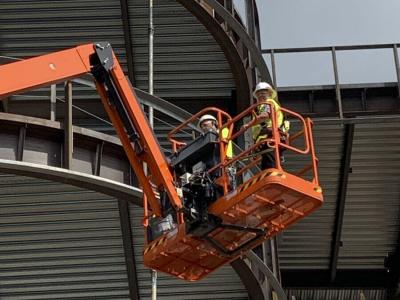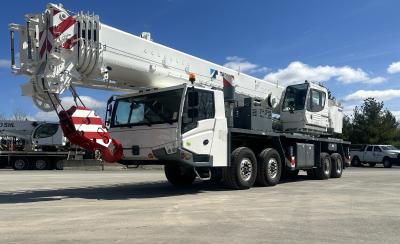Located midway between Chicago and St. Louis, Peoria is Illinois’ oldest community. The four-lane stretch of road traversing the Illinois River to connect Peoria with East Peoria seems like some of the state’s oldest roadway.
Originally built in 1959 prior to the formation of the interstate highway system, the road familiar to present day travelers as Interstate 74 has become outdated and worn. Worse, it has become a safety hazard.
That it has lasted as long as it has, with daily commuters numbering more than 63,000, is a testament to timing. The interstate system was just being formulated under President Eisenhower when the four-lane connector that functions as the main highway through the tri-county area was under construction, and the decision was made to build this stretch of highway to a higher standard than other roads of the time were held to.
But nothing lasts forever, and increased traffic through this Midwest river town has necessitated improvements to the deteriorating and dangerous roadway.
To address the problem, the Illinois Department of Transportation launched “Upgrade 74” in the spring of 2003 –– the largest road reconstruction project in downstate Illinois history.
The $461 million, three-year project consists of three stages aimed at providing motorists with a safer, better looking highway. Under the plan created by eight engineering firms, I-74 from East Peoria through Peoria will be completely removed and replaced; all the ramps will be removed and replaced with safer ramps; 40 bridges will be constructed or reconstructed; and new overpasses, additional lanes, new pavement, new lighting and landscaping will be added.
Exit, Stage One
Walsh Construction Company of Chicago served as the general contractor for Stage One, which was completed in the fall of 2004. Stage One focused primarily on reconstructing many of the bridges and other off-system roadways so they can handle additional traffic during later stages of construction, said George Ryan, IDOT engineer of implementation.
Sterling Avenue was widened from four lanes to six. Riverfront Drive and Camp Street ramps were reconstructed. The main streets crossing over I-74 (Sterling Ave., Gale Ave., University Ave., Broadway Street, Sheridan Road and Ellis Street) were reconstructed. The downtown streets west of Adams (including parts of Spalding Ave., Berkeley Ave., Fayette Street, Perry Ave., Glen Oak Ave., Glendale Ave. and Jefferson Street) were reconstructed.
The Bigelow, Columbia Terrace and Armstrong bridges were permanently removed and part of the substructure of the Columbia Terrace overpass was removed. And a new five-legged intersection at Knoxville and Pennsylvania was constructed. The on/off ramps at this intersection are part of Stage Two work.
Peoria, named for the aborigines discovered by early French explorers, maintains a great deal of civic pride. Home to the nation’s oldest community theater and other cultural venues, as well as big corporations like Caterpillar, the city prides itself on its heritage, history and the quality of life it offers.
Focus groups consisting of community leaders and business owners conferred over the project’s design to ensure Upgrade 74 fit the city’s needs and image, and fit in with the Heart of Peoria Plan to renovate and rejuvenate the downtown district.
Ryan emphasized the fact that IDoT took the time to include the City in the planning.
“We want this project to be the gateway to the City, the motif of the City,” he elaborated. “We needed to include the City to achieve the best result.”
Because work encroached on three historic districts, special attention was paid to aesthetic features. Limestone forms will grace the concrete on wing walls, and a smooth concrete design will help “dress up Peoria.”
One of the challenges during Stage One was dealing with utilities in the downtown area.
“Any time you’re working in an urban area, you’re bound to have major utility conflicts,” Ryan stated.
This project was no exception. Despite pre-planning and initiating projects to move utilities early in Stage One, crews discovered some unknown utility lines.
Communication is a Two-Way Street
Another challenge common to urban areas is the need to minimize disruption.
“Any time you do a project like this, it changes traffic patterns,” explained Ryan. “We want to minimize the impact to businesses and get good information to the public.”
IDOT worked closely with local newspapers and TV and radio stations to get the word out about road closures and lane restrictions. A dedicated web site with updated information about alternate routes records an average of 8,000 hits per day.
IDOT also installed an Intelligent Transportation System. This network of video surveillance cameras, traffic sensors and message boards monitors traffic flow, gathers real-time information and facilitates communication with emergency services and the motoring public about traffic issues. Although it’s one of the first of its kind in downstate Illinois, it is the most integrated ITS throughout the state.
“Our outreach effort has helped the project,” Ryan said. “So far, 99 percent of the comments we receive about the work in progress have been positive.”
In fact, he adds, one of the hospitals along the Interstate issued a thank-you to IDOt via a paid commercial.
Two hospitals –– a Level One trauma center and a Level Two trauma center –– lie on either side of the highway in downtown Peoria. Because the existing ramps were inefficient and potentially dangerous, a new intersection at Knoxville Avenue, new entrance and exit ramps, and a tunnel are being built to allow for more convenient access to the hospitals and downtown.
Concern was expressed about the amount of dust, noise and vibration the project would engender, along with the question of access for emergency vehicles and patients.
In addition to extensive signage pointing out temporary routes to the hospitals, Ryan said updated information regarding changes to the routes was sent to the hospitals, ambulances and patients.
Construction crews constantly monitored the level of vibration, and if work was going to cause significant vibration, IDOT consulted with the hospitals to schedule the work at the least intrusive time.
“It took a lot of coordination,” Ryan said. “The resident engineer talked to them seven or eight times a day.”
In the end, he said, the results exceeded all expectations.
Enter, Stage Two
Stage Two began in the summer of 2004 and is expected to be complete in the fall of 2005. United Contractors Midwest, of Tremont, IL, is acting as general contractor for the second stage.
The scope of work includes: construction of two new tunnels into downtown Peoria; adding new eastbound lanes to I-74; construction of new ramps at Knoxville Ave., Glen Oak and Sterling Ave.; reconstruction of eastbound Washington Street on/off ramps in East Peoria and University Street ramps in Peoria; reconstruction of downtown overpasses at Perry, Monroe, Madison, Jefferson, Adams and Washington, as well as at Nebraska Ave.; raising Adams Street an additional 15 feet above I-74; and the closure of Murray Baker Bridge from April 1 to October 1. A new interchange at Sterling will provide efficient access to downtown’s retail districts and hospitals.
Ryan explained the need to raise Adams Street is due to the fact that the interstate is being raised 10 feet.
“The interstate sags in that area,” he said. “The ramp from Adams to eastbound 74 is short and lower than the road. The accident rate at that interchange is 16 times the average due to poor visibility.”
In fact, 13 of 22 areas along the I-74 corridor exceed the statewide accident average rate, often out-ranking Chicago and East St. Louis.
Bridgework will last approximately six months, and will include widening, steel repairs, stripping of old paint and repainting. Ryan said that because a truss bridge cannot be widened, 180 ft. (54.8 m) of truss will need to be removed from the bridge.
Four other bridges will carry motorists across the river during construction on the Murray Baker Bridge. A flyover ramp at Riverfront Drive in East Peoria was constructed to take motorists from westbound I-74 over the interstate to the Bob Michel Bridge into downtown Peoria.
To reduce the amount of traffic through the city, IDOT has mapped out alternate routes. Routes to circumvent the city include the 474 bypass, IL 29 and Route 150. In addition, IDOT encourages residents to use public transportation and carpooling, and suggests that employers stagger work times to reduce traffic flow during peak times.
Ryan noted that much of the work is conducted behind concrete barriers for protection, and adequate lighting is provided for night work.
“Safety is the Number One priority of the Department,” he proudly stated, adding that the contractors have been very conscientious about safety issues.
Looking Forward to Stage Three
Several contracts await their turn. From the summer of 2005 to the winter of 2006, Stage Three will be in full swing, with work to include the widening of War Memorial Drive and construction of new on/off ramps; widening of Main Street in East Peoria; construction of new westbound I-74 lanes; and reconstruction of Washington Street and westbound on/off ramps in East Peoria. The opening ceremony is scheduled for December 2006. Ryan said they’re currently on schedule and on budget.
The accelerated project includes incentive and disincentive clauses to assure that work is done on time. Ryan explained that after looking at the scope of the work calculated into a five-day work week, IDOT quickly realized it would take years to complete.
Having taken into account costs, motorist delays and inconvenience, they gave contractors a tighter time frame in which to complete the job. That dictates working double shifts, up to 18-20 hours per day.
What Ryan hopes is that the incentives will give contractors a reason to devise innovative ways to produce a quality product in a short time frame.
“We want the contractors to make the incentives,” he confirmed. “We prefer to give this road back to the motorists as quickly as possible.”
Two wet years have caused some problems and slowed work slightly, but a mild winter has allowed work to progress and schedules to remain on target.
By the numbers
At its peak, Stage One witnessed 300 to 350 workers on site each day, not including IDOT personnel and consultants. Ryan expects numbers to double during the Stage Two’s summer peak.
The amount of materials is even more staggering. The project requires more than 110,000 tons (99,000 t) of cement, 250,000 tons 225,000 t) of sand, 379,000 tons 341,000 t) of white rock, 200,000 tons (180,000 t) of gravel, and 400,000 cu. yds. (305 cu m) of concrete. White rock is used for continuously reinforced concrete pavement, bridge decks and bridge parapets.
Stage One used 8.1 million tons (7.3 t) of structural steel, with Stage Two expecting to use 7,677 (6,909 t) tons. Structural steel quantities include bridge beams, H piling and built-up sections, but not pilings for abutments.
Stage One consumed 3.7 million tons (3.33 t) of rebar, with Stage Two expecting to use 7,197 tons (6,477 t). Rebar quantities include rebar used in pavement, decks, walls and abutments, but not pilings for abutments.
Nearly all the materials removed from the bridges are recycled. Concrete from bridges and roads is recycled and used as a base layer for the new roads. Steel from the bridges is recycled locally and shipped to Detroit, where it will be used in automobile production.
Instead of using the typical 20-year design pavement, Upgrade 74 is using a 30-year design.
“It has a beefier base and better aggregate that’s less expansive,” Ryan explained.
Although he deems this an “incredible project” that has proceeded smoothly, he’s looking forward to getting it done –– and he’s not anxious to return in 20 years to repair any of it.
“It takes a lot of long hours to manage a project like this. They don’t go smoothly on their own. Fortunately, we have a lot of good people on site. And one big bridge closure to get through.”
Today's top stories















